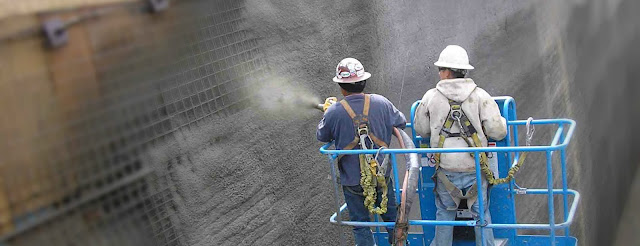Shotcrete can be applied using a dry or wet solution
Shotcrete is a technique for applying concrete at high
velocity to a vertical or overhead surface. The application's impact helps to
consolidate the concrete. Although the hardened properties of shotcrete are
similar to those of conventional cast-in-place concrete, the nature of the
placement process results in an excellent bond with most substrates as well as
rapid or instant capabilities, especially on complex forms or shapes. Shotcrete
requires less formwork and can be less expensive than conventionally placed
concrete. Shotcrete is applied in either a wet or dry mix. Before being
introduced into the delivery hose, the wet-mix shotcrete process thoroughly
mixes all ingredients, including water. At the nozzle, the dry-mix shotcrete
process incorporates water into the mix. Shotcrete
is suitable for curved and thin elements and is used in new construction and
repairs.
Concrete repair entails assessing the current condition of
the concrete structure, determining the causes of deterioration or distress,
and selecting repair methods and materials. A review of available design and
construction documents, structural analysis of the structure in its
deteriorated condition, a review of available test data, a review of records of
any previous repair work, a review of maintenance records, a visual inspection
of the structure, an evaluation of corrosion activity, destructive and
nondestructive testing, and a review of laboratory results from chemical and
petrographic analysis of concrete samples are all possible components of the
evaluation. Following the evaluation, the deterioration mechanism that caused
the deficiency should be identified, and the appropriate repair materials and
methods should be chosen.




Comments
Post a Comment